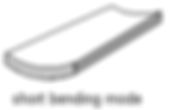More Modes! Free Plate (Plane) & Torsional Modes
In the previous article (Understanding "Bending Modes") we used the ‘string’ analogy to illustrate basic bending mode concepts, and I left you with a ‘teaser’ to imagine how this might translate to a planer surface. I hope you did not lose a lot of sleep worrying this to death… I personally hate those nights where something just keeps agitating my thoughts and I wake up exhausted! I find that whisky can reliably solve the problem - if applied internally! In the ‘string’ example, the ends of the string are ‘fixed’ and cannot move. When we translate this to a plane we are going to assume that the surface is not ‘fixed’ in any manner, and is free to move in all directions. The first thing that will change when we move to this model is that the First Mode ‘nulls’ (the point where there is no movement) will move from the extreme ends of the plane toward the center. If we look at the plane from the side, the shape is identical, a full arc from one end of the plane to the other, however the movement appears to be more complicated.
Note in the diagram that the outer ends of the arc are moving in the opposite direction of the center. The “n” designators on the diagram represent the nulls in the movement. Recall the conversation about phase several discussions back? The center movement is 180 degrees out from the ends!

A three dimensional view of this deflection looks like this:

As I mentioned in the ‘teaser’ there is ALSO a first mode in the ‘short’ direction.

The Second Mode maintains the full cycle sine wave profile, translated to the plane, although once again the extreme ends will be moving opposite of the primary, half-cycle deflection – the nulls slightly inboard of the ends.

And, as with First Long Mode, Second Mode will also exist in the ‘short’ axis
Another interesting thing that shows up when moving to a plane is that additional modes are present that are not seen in our ‘string’ analogy. These modes exist BETWEEN the primary modes in the frequency domain. These are known as TORSIONAL or TILTING Modes. In the First Torsional Mode, the center of the plane becomes the null, like our teeter-totter example in the phase discussion. One end of the plane moves downward and the opposite end moves upward. The cool part in the plane, is that the opposite sides of the plane are 180 degrees out! The plate appears to ‘twist’ - this occurs in both the length, and the width of the plane.


[endif]--
[endif]--
This First Mode is typically the lowest frequency mode shape in the plane. Moving up the frequency scale, the next mode that will exist is First Torsional Mode, above this will be Second Bending Mode, followed by Second Torsional, and so on… Interspersed within the ‘long’ modes will be the ‘short’ modes, but their exact position in the frequency progression will be determined by the ratio of the length to width.

[endif]--
The models we are considering here are all idealized as a ‘free’ structure that can move in any direction with no resistance, and in the real world this is never the case. All of the various parts of a machine are interconnected, affecting the overall rigidity of the system. Some components may be heavily dampened and others may be easily excited to resonance. There is a BUNCH of stuff going on, every time we press the start button! The final concept to come to grips with, is that ALL of these modes exist simultaneously within the structure, with the lower modes having the most physical movement. Any of these modes can be excited by a driving frequency that coincides with the resonant frequency of the mode.
It may now be time for that shot of whisky…
![endif]--![endif]--![endif]--















